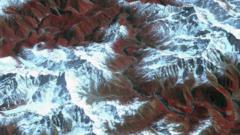The Yarlung Tsangpo river project is seen as a potential threat to water security in downstream nations, prompting urgent calls for transparency from Beijing.
China Unveils Ambitious Plan for World's Largest Hydropower Dam, Raising Alarm in South Asia

China Unveils Ambitious Plan for World's Largest Hydropower Dam, Raising Alarm in South Asia
Concerns grow in India and Bangladesh as China begins construction on a massive dam in Tibet, set to become the largest globally.
Chinese authorities have initiated construction on what is projected to be the world's largest hydropower dam situated in the Yarlung Tsangpo canyon, a region known for its immense depth and size. The commencement of the project, overseen by Chinese Premier Li Qiang, has raised significant concerns in both India and Bangladesh, who fear the ecological and economic ramifications of the development.
The dam, dubbed the Motuo Hydropower Station, aims to generate energy equivalent to three times that of the famed Three Gorges dam. Costing approximately $12 billion yuan (or $1.67 billion), its completion is expected to significantly enhance China's energy capacity while potentially disrupting millions of lives downstream.
Experts note that with this new dam, China may gain unprecedented control over the Yarlung Tsangpo river as it flows into Indian states like Arunachal Pradesh and Assam, as well as Bangladesh. Concerns have been underscored by Arunachal Pradesh Chief Minister Pema Khandu, who stated that the dam could lead to severe reductions in water flow for the Siang and Brahmaputra rivers, subsequently threatening local livelihoods and tribes.
In response to these fears, India's Ministry of External Affairs has urged China to consider the implications for downstream nations and emphasize the importance of transparency in their actions. India is also pursuing its own hydropower initiatives to protect its interests, particularly against rapid water release from the new dam.
The project finds its foundation in the rugged terrain of Tibet, where the Yarlung Tsangpo river, after making a notable bend around Namcha Barwa mountain, drops steeply in elevation. Plans entail drilling extensive tunnels for water diversion, leading to the construction of five major power stations.
China has been focusing on harnessing hydropower in its western regions to meet the energy demands of its industrialized eastern areas, as per the "sending western electricity eastwards" initiative championed by President Xi Jinping. This development has incurred criticism due to its impact on Tibetan lands and local populations, highlighting a broader history of exploitation.
Despite the government's portrayal of these projects as environmentally friendly and beneficial to local communities, human rights advocates assert that the construction represents continued oppression of Tibetan voices and an ongoing disregard for environmental safety, given the region's susceptibility to seismic activity.
With Bangladesh also expressing its concerns in the form of formal communications to the Chinese government, the implications of the dam extend beyond China's borders, marking a pivotal moment in the geopolitical landscape of South Asia.
The dam, dubbed the Motuo Hydropower Station, aims to generate energy equivalent to three times that of the famed Three Gorges dam. Costing approximately $12 billion yuan (or $1.67 billion), its completion is expected to significantly enhance China's energy capacity while potentially disrupting millions of lives downstream.
Experts note that with this new dam, China may gain unprecedented control over the Yarlung Tsangpo river as it flows into Indian states like Arunachal Pradesh and Assam, as well as Bangladesh. Concerns have been underscored by Arunachal Pradesh Chief Minister Pema Khandu, who stated that the dam could lead to severe reductions in water flow for the Siang and Brahmaputra rivers, subsequently threatening local livelihoods and tribes.
In response to these fears, India's Ministry of External Affairs has urged China to consider the implications for downstream nations and emphasize the importance of transparency in their actions. India is also pursuing its own hydropower initiatives to protect its interests, particularly against rapid water release from the new dam.
The project finds its foundation in the rugged terrain of Tibet, where the Yarlung Tsangpo river, after making a notable bend around Namcha Barwa mountain, drops steeply in elevation. Plans entail drilling extensive tunnels for water diversion, leading to the construction of five major power stations.
China has been focusing on harnessing hydropower in its western regions to meet the energy demands of its industrialized eastern areas, as per the "sending western electricity eastwards" initiative championed by President Xi Jinping. This development has incurred criticism due to its impact on Tibetan lands and local populations, highlighting a broader history of exploitation.
Despite the government's portrayal of these projects as environmentally friendly and beneficial to local communities, human rights advocates assert that the construction represents continued oppression of Tibetan voices and an ongoing disregard for environmental safety, given the region's susceptibility to seismic activity.
With Bangladesh also expressing its concerns in the form of formal communications to the Chinese government, the implications of the dam extend beyond China's borders, marking a pivotal moment in the geopolitical landscape of South Asia.




















